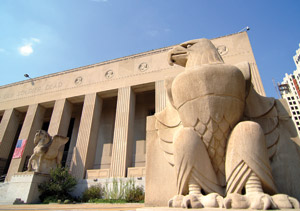Scene
Soldiers’ Memorial Military Museum
Located downtown, the Soldiers’ Memorial is often overlooked when one thinks of St. Louis museums. A mere half mile from Union Station, the memorial has served as a testament to the soldiers from Missouri, who, according to the museum’s Web site, “made the supreme sacrifice in the [first] World War.”
Its construction is actually a somewhat tragic story. Beginning in the years following World War I, plans were made to erect a memorial recognizing the servicemen of the Great War. Ground was broken in 1935, and the memorial and museum officially opened on May 30, 1938. This was just half a year before the start of World War II, making the memorial an almost terrible irony. President Franklin Roosevelt dedicated the memorial on Oct. 14, 1936, remarking on the American wish to commemorate the sacrifices made in war and serve as an emblem of peace. Unfortunately, a little more than five years later, in December 1941, the United States officially entered World War II—the deadliest conflict in human history.
Despite its tortured creation, the building itself is an architectural marvel. Built to resemble a stripped down Greco-Roman temple, the memorial stands out from the other buildings downtown. Massive stone pillars line the sides, 14 each in the front and back and seven on the sides. Above the pillars stand engraved medallions that represent the various armed forces and enlisted men of World War I.
Flanking the entrance on either side of the building are two Pegasus figures, four in total. A human statue stands next to each of them. On the south side, “Courage” and “Vision” stand at the top of the steps, while “Loyalty” and “Sacrifice” are located on the north side. The human figures are male and female, respectively. The statues represent some of the most common traits associated with soldiers in battle, and they stand in majestic poses. They continue the Greco-Roman sculptural tradition and are dignified, heavily muscled and often armed with swords, furthering the overtly classical influence.
The open-air atrium is the centerpiece of the memorial with a cenotaph—a monumental tomb—placed within it. This structure was constructed out of Bedford limestone from south-central Indiana and bears the names of 1,075 servicemen and women from St. Louis who died during World War I. The ceiling of the atrium is remarkable in its own right. Constructed as a mosaic, the ceiling is tinted gold, silver and red, with a gold star in the center. The atrium as a whole—the ceiling and cenotaph especially —serves to create a public area where people can individually contemplate and appreciate the sacrifices that war requires.
On either side of the atrium are the museums of the memorial, which showcase military objects of significance, including flags, uniforms and firearms. Exhibitions often, but not always, cover the military history of Greater St. Louis. Current exhibits include “Montford Point Marines: Black Marines of WWII” and “American Superheroes: Popular Culture and the St. Louis War Experience.”
Overall, the monument stands as a testament to the sacrifices Americans made in the Great War and all subsequent ones. From its Greco-Roman roots, which celebrate the valor and bravery of those in war, to the museum, which examines the historical significance of wars, the memorial is fitting to those who fought and fell in defense of the United States.
The metaphorical capstone of the memorial, the atrium, is the heart of the cairn. As a whole, the impressive museum provides a proper memorial for the valiant Missouri soldiers who fought in World War I.

